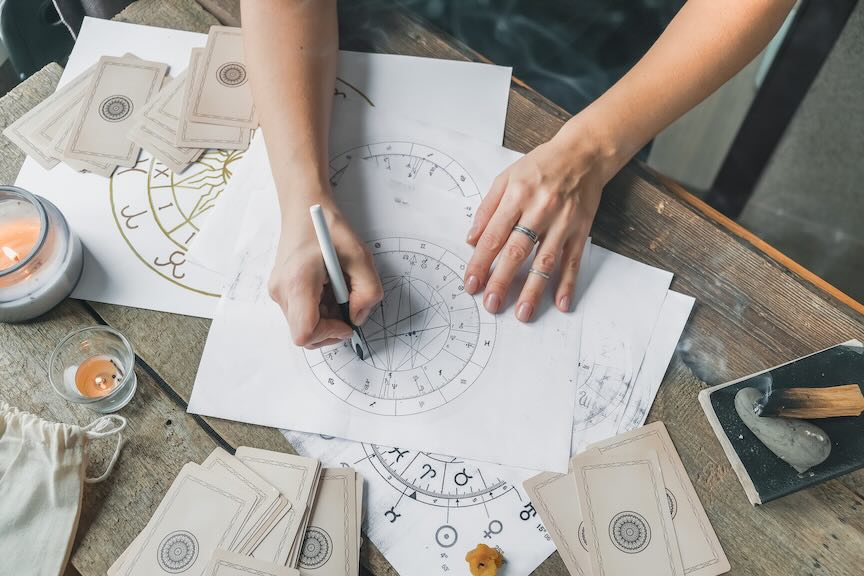The Origins of Astrology: Tracing Back to Ancient Civilizations
by Joyce David
Have you ever looked up at the sky at night and wondered what secrets could the stars share? You wouldn’t be the first, as the celestial bodies have fascinated humanity for hundreds of years, after all.
From the earliest stargazers of ancient Mesopotamia to the philosophers of Greece, we searched the heavens for answers to life’s mysteries. But how exactly has modern astrology come to be?

Early Days of Astrology
Astrology traces its roots back to Mesopotamia, back to 2000 BCE. The Babylonians were the first to study the stars and planets systematically, mapping patterns in the sky and tracing correlations those had with the events on Earth. Those were the first early studies that laid the foundation for what we can explore today in more detail on dedicated websites like Nebula.
They thought that changes in the skies could predict major natural occurrences, like flooding or drought. Aside from that, the Babylonians even believed that they could predict even political changes, with the readings of the celestial bodies.
This early form of astrology was designed to address events as grand as the fates of the kingdoms—not the paths of each individual. The Babylonians, however, are believed to have developed the basic zodiac sign system, essentially dividing the sky into twelve equal parts now known as the twelve signs of the zodiac. Their observations laid the foundation for much of what we know of astrology today.
In Egypt, a similar exploration took on an even greater scale. The Egyptians watched the stars rather closely, particularly Sirius, which they associated with the flooding of the Nile—a very important event for their agriculture.
They also linked astrology with their religious beliefs. Astrology wasn't just about predicting earthly events—it was a spiritual practice deeply intertwined with the cycles of life and death.
The Golden Age of Astrology
During the Hellenistic era, from the 4th to the 1st century BCE, Greek culture combined the knowledge of that of Babylonian and Egyptian explorations. It was a very innovative period, and astrology became a form of science, as well as a spiritual practice.
The Greeks took astrology one step further by introducing the horoscopes. Unlike earlier systems, which were concerned with broad-scale events affecting everyone in general, horoscopes brought astrology to a more personal level. It became possible to delve deeper into individual destiny and create the first personalized readings.
There are many names associated with developing knowledge in this field of study. One of the most influential men was a Greek scholar named Ptolemy, who wrote the work known as "Tetrabiblos." This became the root of Western astrology in explaining how planets and stars influenced the lives of people. The Greeks also started associating their gods and legends with the planets and zodiac signs. Telling stories with the stars made astrology a part of their culture.
Greek astrology was adopted by the Romans, who spread it throughout their empire. No longer was astrology restricted to the elite—it reached the public, and people started to seek out astrologers for personal advice. Even Roman emperors consulted astrologers on their political decisions. During this time, astrology truly became part of everyday life.
Meanwhile, ancient India was developing their own beliefs. Vedic astrology, or Jyotisha, is said to trace its roots back to 1500 BCE and find its origins in the Vedas, ancient sacred texts.
Unlike Western astrology, mainly based on the positioning of the Sun, Vedic astrology focuses more on the moon and its cycles. A somewhat different tradition, Vedic astrology continues to be a significant part of culture in India, influencing everything from dates of weddings to major life decisions.
Modern Days and Astrology’s Influence Across Cultures
Astrology resurfaced in Europe during the Middle Ages. It became the object of academic study, paired with alchemy and medicine. A plethora of the great thinkers of the time including Galileo and Johannes Kepler studied astrology. Throughout the Renaissance, astrological symbols appeared in art and literature, showing their influence on culture.
In the 20th century, there was another big resurgence of astrology. The horoscopes became a regular feature in newspapers, which brought astrology to the masses. The New Age movement of the 1960s gave astrology a new breath, making it into what it is today—a system of spiritual beliefs and a way of self-exploration. People began to view astrology as a means to understand themselves better.
The modern technology, of course, changed everything once again. The internet, apps, and online platforms put astrological insights one click away from any regular user, making it particularly accessible. Now, people from all over the world can explore their birth charts, read daily horoscopes, or find guidance from astrologers by simply visiting a website. If you are interested in those topics, feel free to read more about them.
Closing Thoughts
We can find astrology in various traditions even today. Western studies, Indian Vedic beliefs, and Chinese astrology—all display nuanced systems that reflect their respective cultures and histories. All forms of astrology, nonetheless, share one common objective: it links the distant mystic skies to our life on Earth.
 >
>